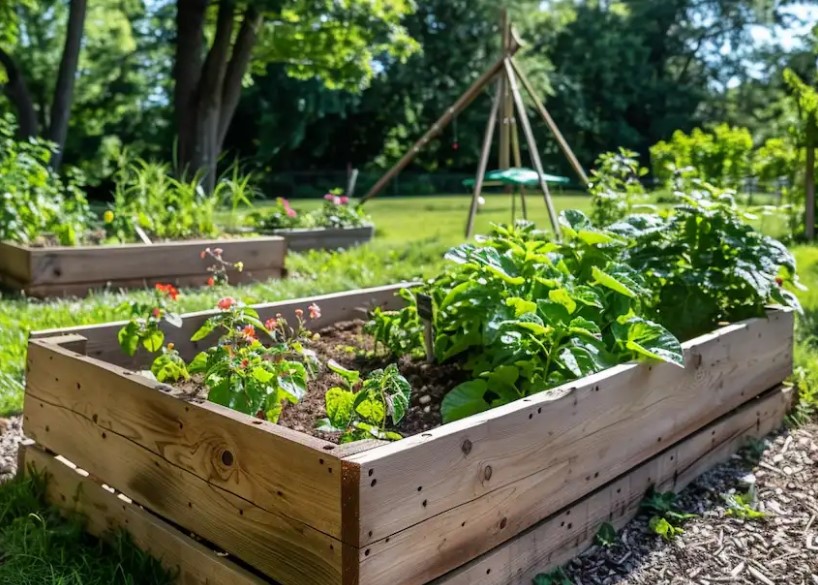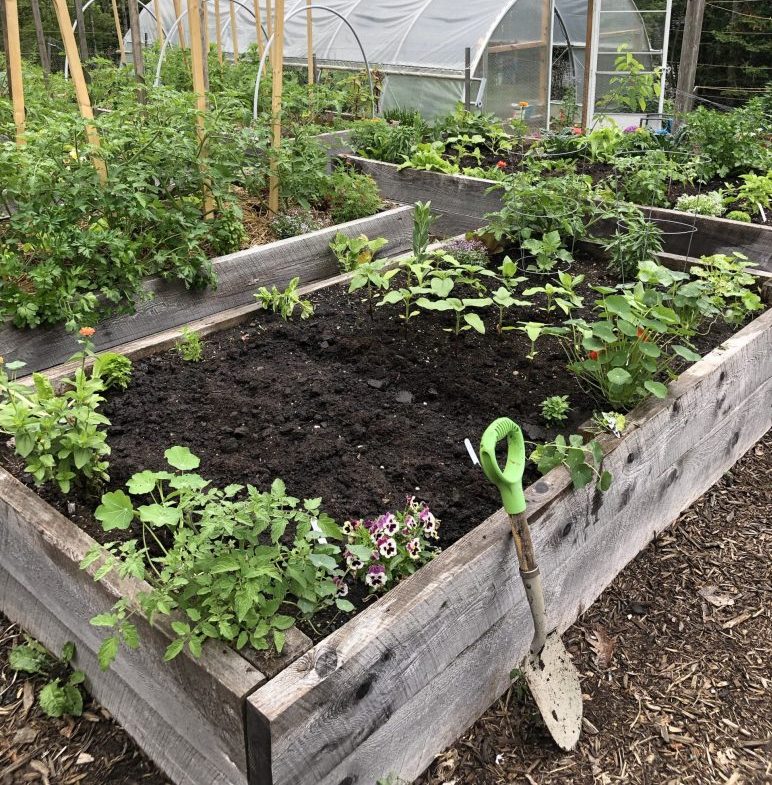Creating a productive and beautiful vegetable garden begins with the foundational step of constructing a garden bed. This guide is designed to walk beginners through building a basic raised garden bed, followed by preparing the ideal soil mix for planting. Raised beds offer numerous benefits, including improved soil conditions, better drainage, and easier access for maintenance. Let’s start by building your first garden bed.

Building Your First Garden Bed
Materials Needed:
- Untreated wood planks (e.g., cedar or redwood) to avoid chemicals leaching into the soil
- Wood screws or nails
- Drill or hammer
- Landscape fabric (optional for extra weed protection)
- Cardboard for the bottom of the bed
- Soil mix (to be prepared later)
Step-by-Step Construction:
Step 1: Design Your Bed
Decide on the size of your garden bed. A manageable size is 4 feet by 8 feet, allowing easy reach to the center from both sides. Choose a location that receives at least 6 to 8 hours of sunlight daily.
Step 2: Cut and Assemble the Frame
Cut the wood to your desired lengths. Assemble the frame into a rectangle or square by securing the planks together with wood screws or nails. Incorporate corner posts for additional support if desired.
Step 3: Prepare the Site
Choose a level area for your bed. Clear it of grass and weeds. Although optional, you can lay landscape fabric over this area to further hinder weeds.
Step 4: Add Cardboard Bottom
Before placing the frame in its designated spot, cover the ground with cardboard. This eco-friendly layer will suppress weeds naturally as it decomposes, improving soil health beneath your bed.
Step 5: Position the Frame
Set your frame over the cardboard-covered area. The cardboard should extend slightly beyond the frame’s perimeter to ensure comprehensive weed suppression.
Step 6: Fill with Soil
Now that your bed is in place, it’s time to prepare and add the soil mix, which will be detailed in the following section of this guide.
With your garden bed constructed, you’re ready to move on to preparing the soil that will nourish your plants. A well-built bed and properly prepared soil are the keystones of a successful vegetable garden, laying the groundwork for healthy plant growth and abundant harvests.
Understanding the Ideal Soil Mix
For a beginner gardener, aiming to grow a variety of vegetables, the magic lies in the soil composition. A mix of 60% topsoil, 30% compost, and 10% sand or perlite is recommended for vegetable gardens. This blend provides a nutrient-rich base, ensures adequate moisture retention, and offers proper drainage, creating an optimal growing environment for your food crops.
Why This Mix Works
- 60% Topsoil: Forms the foundation of your garden bed, supplying essential minerals and a base for your plants to root into.
- 30% Compost: Enriches the soil with vital nutrients and organic matter, promoting healthy plant growth and improving soil structure for better water retention.
- 10% Sand or Perlite: Enhances soil drainage, preventing water from pooling around the roots, which is crucial for preventing diseases like root rot.
Step-by-Step Guide to Preparing Your Garden Bed
Step 1: Clear and Measure Your Garden Bed
Start by clearing the area of weeds, stones, and debris. Measure your garden bed to estimate the volume of soil mix needed.
Step 2: Combine Your Soil Components
In a large container or directly in the bed, mix your components thoroughly—60% topsoil, 30% compost, and 10% sand or perlite. This creates a uniform and balanced soil ready for planting.
Step 3: Test and Adjust Drainage
Water the mix slightly and observe the drainage. If it drains too slowly, consider adding a bit more sand or perlite. Your goal is for the water to seep through at a steady, moderate pace.
Step 4: Fill Your Garden Bed
Transfer your soil mix into the garden bed, filling it to just below the rim. Level the surface with a rake to prepare for planting.
Step 5: Plant and Mulch
After planting your vegetables, apply a layer of mulch. This helps retain moisture, suppress weeds, and gradually adds organic matter to the soil.
Final Thoughts
Remember, the key to a successful vegetable garden is not just in the planting but in preparing a nurturing environment for your plants to thrive. The 60-30-10 soil mix is a beginner-friendly starting point that supports a wide range of vegetables by providing the nutrients, moisture, and drainage they need. As you gain experience, don’t hesitate to tweak the mix based on the specific needs of your garden and observations of your plants’ growth.
Gardening is a journey of learning and discovery. By starting with a solid foundation, you’re well on your way to enjoying a bountiful harvest and the rewarding experience of growing your own food. Happy gardening!










